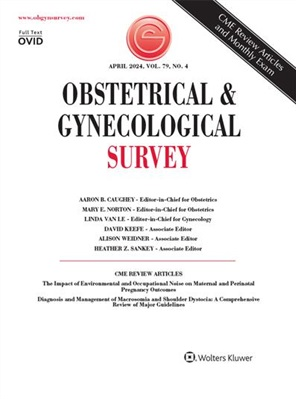附件扭转手术治疗方法的改变:国家外科质量改进计划数据库的分析
IF 3.6
4区 医学
Q1 OBSTETRICS & GYNECOLOGY
引用次数: 0
摘要
卵巢扭转发生在卵巢自身的支撑韧带扭曲时,导致缺血和可能的坏死。这是一种恢复附件灌注的紧急手术,即使在出现坏死的卵巢的情况下,与卵巢切除术相比,仅采用扭曲的保守治疗不会增加术后并发症。传统上,在这些情况下进行卵巢切除术,尽管新的证据支持卵巢保护,卵巢切除术仍然很常见。尽管美国妇产科学会(ACOG)在2016年更新了指导方针,但尚不清楚自那以后的几年里,实践模式发生了多大程度的变化。本回顾性队列研究旨在描述2008年至2020年间卵巢扭转手术治疗的趋势,并描述更新的ACOG指南发布前后治疗的变化。美国外科医师学会国家手术质量改进计划(NSQIP)数据库用于识别2008年至2020年期间接受附件扭转手术的18至50岁女性。使用ICD编码将患者分类为接受过卵巢切除术或卵巢保护的患者,排除同时接受手术或与妊娠相关或与附件扭转无关的手术的患者。然后将患者分为前acog指南(2008-2016)和后acog指南(2017-2020)。对患者人口统计学、临床资料、围手术期特征和术后30天不良事件进行查询和比较。主要结局是卵巢切除术的比例,描述为卵巢切除术的数量超过每年所有扭转手术的总数,置信区间为95% (CI)。在控制混杂因素的情况下,进行多变量回归分析以确定年度队列中卵巢切除与卵巢保留的几率。本研究共纳入1791例患者,其中2008-2016年队列402例(22.4%),2017-2020年队列1389例(77.6%)。在两组中,542例(30.3%)患者接受了卵巢保护,1249例(69.7%)患者接受了卵巢切除术。2008-2016年和2017-2020年队列中卵巢切除术的总体比例相似(71.9% vs 69.1%;校正优势比为0.94;95% ci, 0.71-1.25)。在评估时间对卵巢切除几率的影响时,发现在整个研究期间,每年连续进行卵巢切除的几率显著下降(平均下降- 1.6%/年;95% CI, - 3.0%至- 0.22%),尽管2017年前后卵巢切除术几率的年连续下降保持相似。与保留卵巢组相比,卵巢切除术组的住院时间中位数更长,住院率较高。本研究的结果表明,69.7%的附件扭转手术涉及卵巢切除术,而不是保守治疗,尽管在研究期间观察到一个适度的统计趋势,即卵巢切除术减少。在ACOG推荐卵巢保护的指南发表前后,没有观察到卵巢切除术与卵巢保护的趋势有明显的影响。本文章由计算机程序翻译,如有差异,请以英文原文为准。
Changing Practices in the Surgical Management of Adnexal Torsion: An Analysis of the National Surgical Quality Improvement Program Database
ABSTRACT Ovarian torsion occurs when the ovary twists on its own supporting ligaments, resulting in ischemia and possible necrosis. This is a surgical emergency to restore adnexal perfusion, and even in the setting of a necrotic-appearing ovary, conservative management with detorsion alone does not increase postoperative complications compared with oophorectomy. Traditionally, oophorectomy was performed in these cases, and despite the new evidence supporting ovarian conservation, oophorectomy remains common. Despite updated guidelines by the American College of Obstetricians and Gynecologists (ACOG) in 2016, it is unclear to what extent practice patterns have changed in the years since. This retrospective cohort study aimed to describe the trend in surgical management of ovarian torsion between 2008 and 2020 and to describe the changes in management before and after the publication of the updated ACOG guidelines. The American College of Surgeons National Surgical Quality Improvement Program (NSQIP) database was used to identify women aged 18 to 50 years who underwent surgery for adnexal torsion between 2008 and 2020. Patients were classified as having undergone oophorectomy or ovarian conservation using ICD codes, and patients undergoing concurrent surgeries or procedures related to pregnancy or unrelated to adnexal torsion were excluded. Patients were then grouped into pre-ACOG guidelines (2008–2016) and post-ACOG guidelines (2017–2020). Patient demographics, clinical data, perioperative characteristics, and 30-day postoperative adverse events were queried and compared between year cohorts and surgical management groups. The primary outcome was proportion of oophorectomies, described as the number of oophorectomies over the total number of all torsion surgeries per year, with a 95% confidence interval (CI). Multivariable regression analysis was conducted to determine the odds of oophorectomy versus ovarian conservation between year cohorts while controlling for confounders. A total of 1791 patients were included in this study, with 402 (22.4%) in the 2008–2016 cohort and 1389 (77.6%) in the 2017–2020 cohort. Across both groups, 542 patients (30.3%) underwent ovarian conservation, and 1249 (69.7%) underwent oophorectomy. The overall proportion of oophorectomies was similar between the 2008–2016 and 2017–2020 cohorts (71.9% vs 69.1%; adjusted odds ratio, 0.94; 95% CI, 0.71–1.25). When evaluating the effects of time on odds of oophorectomy, a significant decrease in the odds of oophorectomy performed successively each year over the entire study period was found (average decrease, −1.6%/year; 95% CI, −3.0% to −0.22%), although the yearly successive decrease in the odds of oophorectomy remained similar before and after 2017. The median hospital length of stay was longer, and the hospital admission rates were high in the oophorectomy group compared with the ovarian conservation group. The results of this study demonstrate that 69.7% of surgeries for adnexal torsion involved oophorectomy rather than conservative management, although a modest statistical trend toward fewer oophorectomies over the study period was observed. No observable effect on the trend of oophorectomy versus ovarian conservation was observed before and after the publication of ACOG guidance recommending ovarian conservation.
求助全文
通过发布文献求助,成功后即可免费获取论文全文。
去求助
来源期刊
CiteScore
2.70
自引率
3.20%
发文量
245
审稿时长
>12 weeks
期刊介绍:
Each monthly issue of Obstetrical & Gynecological Survey presents summaries of the most timely and clinically relevant research being published worldwide. These concise, easy-to-read summaries provide expert insight into how to apply the latest research to patient care. The accompanying editorial commentary puts the studies into perspective and supplies authoritative guidance. The result is a valuable, time-saving resource for busy clinicians.

 求助内容:
求助内容: 应助结果提醒方式:
应助结果提醒方式:


